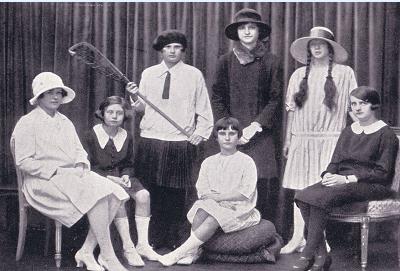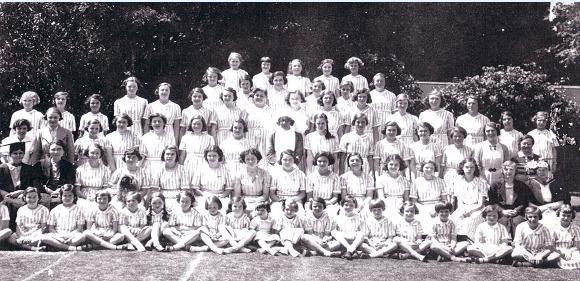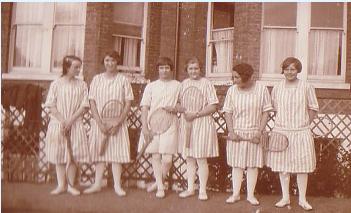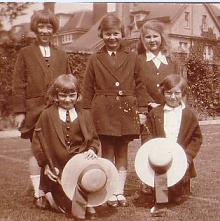The summer dresses were of blue and white striped cotton, but the stripes were an inch wide and the effect was very different from the post-war material with narrow stripes. The horizontal stripes across the hips formed a sort of built-in belt. Juniors used the same material but a different dress pattern. Summer coats and raincoats were of gabardine.
The boater had been replaced by a distinctive design copied from those worn by Breton fishermen. It was of straw with a high crown, very wide brim and navy blue ribbons hanging down behind. They were retained until 1940. The girls called these hats ‘floppers or ‘mushrooms’. Patricia Swinhoe-Phelan remembers the difficulty caused by the floppers while sitting in Church. If one leant against the pew the ribbons were trapped behind one’s back, and a pious bowing of one’s head pulled the hat backwards so that it fell off into the pew behind.
Sonia Speich has a happy memory of "the entire school gathered in the sun outside Holy Trinity Church on Empire Day ready to march past the flag single file saluting as we went. We wore our Summer dresses and the distinctive ‘mushroom straw hats with the broad navy blue ribands. The hats could appear rather large on some of the smaller children."
For summer Sundays boarders dressed all in white: dress, coat, gloves, stockings and shoes, with a small, shiny straw hat. In bright sunshine the brilliance of this outfit dazzled the eyes.
Winter dresses were of navy blue worsted, gathered each side of the waist, a bodice with wooden buttons and cream coloured shantung Peter Pan collars which had to be unpicked and removed every weekend and replaced by sewing on a clean one. Blue overalls, gathered onto circular yokes, buttoned at the back and modelled on Breton fishermen garments, were added for lessons to keep ink off the dresses.
The winter coat was of navy blue velour with a yoke across the back. At first it had a squirrel fur collar but this was discontinued by the thirties.
The early winter hats of this period were of navy velour with a navy petersham ribbon cockade at one side. Later they were navy ‘floppers with streamers, and in 1937 a narrow-brimmed hat with a petersham band was introduced.
The boarders had black velvet dresses with lace collars to change into for the evening and for Sundays in winter.
In the twenties the girls wore black stockings and shoes. Suzanne Farran recalls the fuss made when a day-girl walked in wearing flesh-coloured silk stockings and snake-skin shoes. Later they wore brown stockings in either wool or lisle. After several washes the lisle stockings, though hard-wearing, changed to a variety of unattractive shades ranging from grey to mustard.




